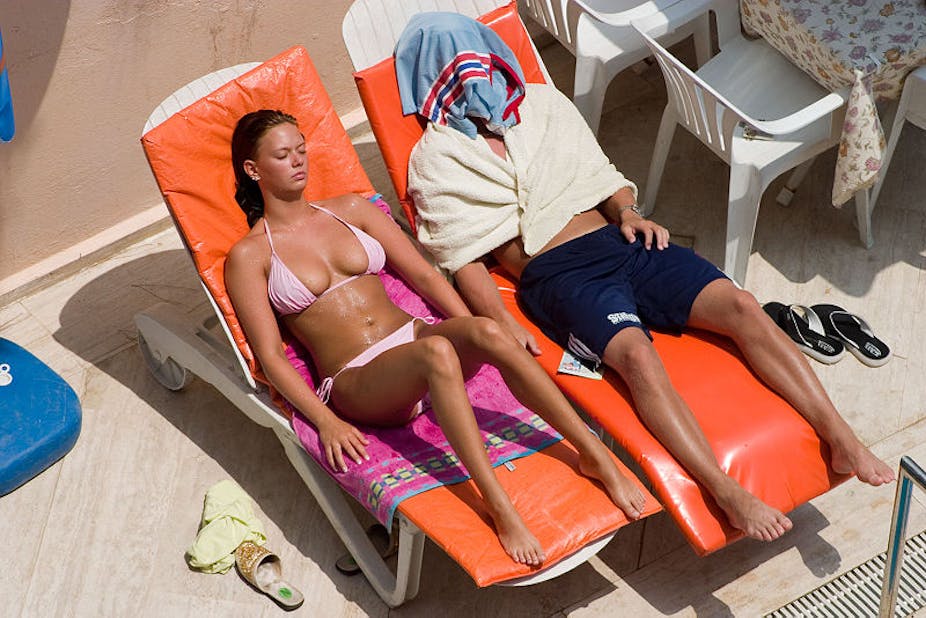Despite the many awareness-raising campaigns on the harmful effects of ultraviolet (UV) radiation, a walk along any tourist beach will tell you just how many sun worshippers continue to soak up the sun excessively. And despite our use of all kinds of sunscreens, the statistics show a constant increase in the number of skin cancer cases. Why?
Things that protect us against harmful rays from the sun include clothing such as hats and longer sleeves and sunglasses. But topical sun protection from sunscreens is ideal as it allows us to be more free.
These products only appeared on the market in the 1930s and were promoted as tanning aids. The formulation of sunscreen products is complex and the first ones were especially flawed – because the UV-filters were used at low concentrations and their effectiveness was limited in UVB light range. Since then, the history of topical sun protection has been marked by milestones, or scandals as we could call them. Let’s not forget the Bergasol affair in the 1980s. Products were formulated with bergapten, a photo-sensitising molecule that is found in bergamot essential oil and other oils, but which had no place whatsoever in this type of product because mixed with light it can cause skin irritation.
Today we have the Sun Protection Factor (SPF) to guide us. SPF is a universal indicator that testifies to the effectiveness of a product against UV (which includes UVA and UVB wavelengths), which can penetrate and damage the skin and cells. SPF is worked out by putting on a thick layer of a suncream on in the lab and working out the difference it makes based on a multiplier – so if unprotected skin took 15 minutes to burn, a sunscreen with an SPF of 10 would take 150 minutes, and SPF30 would take 450 minutes.
This method of calculating protection is voted for overwhelmingly by manufacturers. Apart from the clear ethical shortcomings of this method (it does, after all involve irradiating volunteers for not insignificant periods or doses), we’ve discovered and revealed a certain number of potential biases. We’ve tested many products each year since 2000 and would say that about a third have much less protection than their SPF would suggest.
Concerns have previously been raised about SPF performance out in the real world and a recent investigation by Which? consumer magazine found three suncreams – Piz Buin, Malibu and Hawaiian Tropic – had lower protection than the SPF30 on the bottle.
Anti-inflammatories
We’ve highlighted that a certain number of ingredients found in suncreams including allantoin (a molecule found in Symphytum officinale, a plant more commonly known as comfrey but which is now mostly synthetic), bisabolol (found in chamomile, also now mostly synthetic), and liquorice extracts, are likely to inhibit the appearance of redness due to their anti-inflammatory properties. As redness is a clinical sign that is used to determine SPF under current procedures, it can result in an overestimation of the SPF of products that contain these molecules. Using products high in anti-inflammatories can give a false sense of security – your DNA is still being damaged, you just don’t see or feel it happening.
We have also demonstrated that the majority of filters approved in sunscreen products, including salicylates, benzophenones, PABA by-products, cinnamates and octocrylene, are highly anti-inflammatory. The problem is that despite this UV-filters are an essential ingredient for sunscreens to work.
Our current work has been looking at how long these anti-inflammatory effects last and we’ve found that this can be several hours. It’s worth bearing in mind that any molecule that is likely to inhibit the development of the redness, regardless of what other action it has, will plays a part in overestimating SPF using current measures.
Another major problem with topical sun protection comes from mineral products – titanium dioxide and/or zinc oxide – whether or not they are organic. Despite some claims, high SPF factors in sunscreens (50, 50+) can’t be obtained with this type of sunscreen. Again the difference is due to an anti-flammatory effect and people who use these type of products for high SPF won’t be well protected.
A better way to test?
Instead, we think there should be a new standardised system of testing products based on chemical testing in the lab that only considers the optical properties of filters. This is the only way of quantifying the real effectiveness of sunscreen products.
Sunscreen products are different from all others; they can actively protect against skin cancers. And crucially, we have trust in them so happily stay out in the sun longer, thinking they’re working as well as they claim. It would therefore be appropriate that they return to being classed as a medication, as they are in the US. The marketing of ineffective sunscreen products today will have to take a share of the responsibility in skin cancers – we can’t leave this heavy responsibility to the cosmetics industry.

